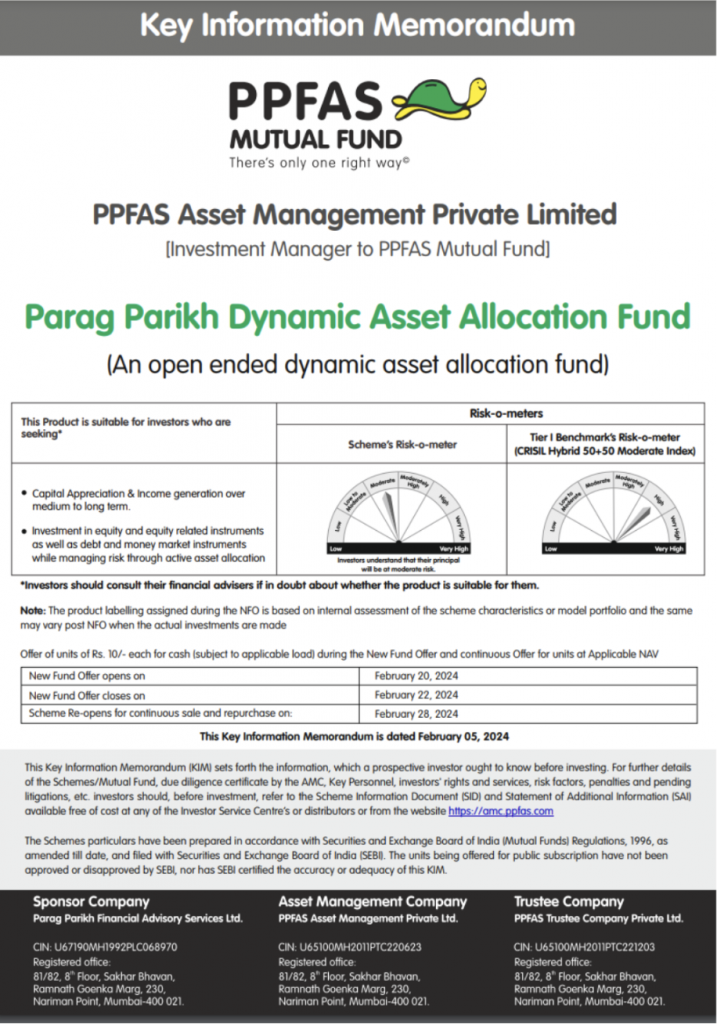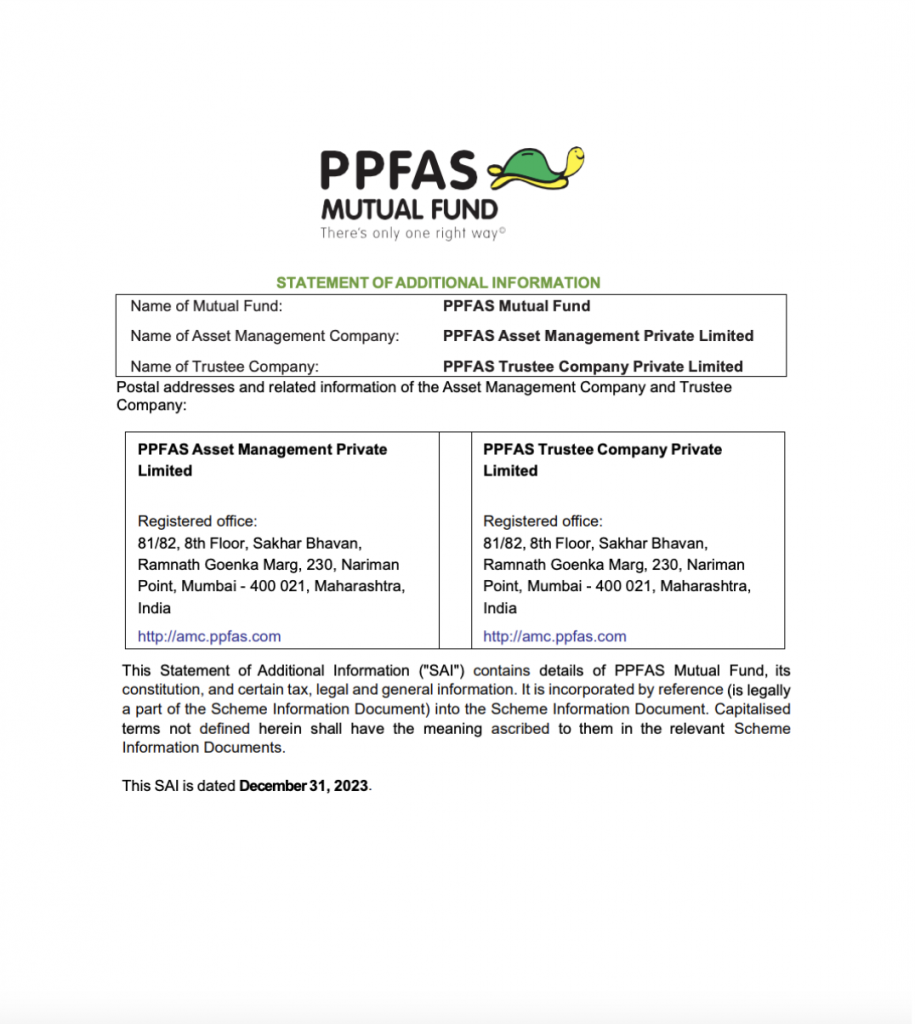Chapter 5: Important Documents of a Mutual Fund
“Mutual funds are subject to market risk. Please read the documents carefully before investing!”
Have you heard this before? Why is this statutory warning clearly stated as a disclosure after every “Mutual Fund Investing” advertisement on television, print, or social media?
3 main scheme-related documents are mandatory to be offered to every investor, namely:
- KIM – Key Information Memorandum.
- SID – Scheme Information Document.
- SAI – Statement of Additional Information.
Both documents are prepared in the format prescribed by SEBI, and each mutual fund must submit them to SEBI. The contents must flow in the same sequence as the prescribed format. The mutual fund can add any other disclosure it feels is ‘material’ for the investor.
SEBI has made it very clear that by law, every mutual fund house has to share this disclosure mentioning the risks involved in mutual fund investing so that every investor who decides to invest makes an informed decision before they start investing.
Mutual fund AMCs have to offer these important scheme-related documents (which we shall discuss in this chapter), which contain all the possible information an investor “needs to know” or, let us say, “has to know” about mutual fund schemes and the Mutual Fund House/ AMC as well.
These scheme-related documents not only explain the risks involved in MF investing but also disclose where the AUM is being invested and all the information about the risks involved that can impact your savings through investing through the selected mutual fund scheme.
It’s great practice, isn’t it? Especially in finance, where it’s imperative to learn about all the possible risks involved before investing rather than losing money and then learning.
It’s worth noting that MF investing is governed by the “caveat emptor” principle, which means “ let the buyer beware.” Hence, an investor is assumed to have made an informed decision by carefully reading all the scheme-related documents offered before investing.
Since MF is a contractual arrangement, the investor signing the application form has legally accepted the terms of the offer by the Mutual Fund House. Therefore, an investor cannot claim in the future to be unaware of any information or that the information was not shared since all scheme-related information is disclosed in the scheme-related documents.
Therefore, it’s crucial to know what these offered documents are and decode them so that you know exactly what you are getting into the next time you choose to invest in MFs.
So, let’s decipher these scheme-related documents and understand how to read them.
Key Information Memorandum (KIM)
A Key Information Memorandum (KIM) sets forth the information a prospective investor should know before investing.

KIM is a comprehensive statement that provides all the basic information about a Mutual Fund, AMC, and scheme at a glance.
For any further details of the Schemes/Mutual Funds, like a due diligence certificate by the AMC, its Key Personnel, the rights of the investors, risk factors, etc., that investors should know before investment, investors can refer to the Scheme Information Document (SID) and Statement of Additional Information (SAI) available free of cost at any of the Investor Service Centres or distributors or from the website.
SID - Scheme Information Document
A SID is a detailed version of the KIM that explains everything about the Mutual fund, its AMC, and the scheme in detail.
The initial SID contains the following information:
- Name of the Scheme – Every scheme is given a name that usually precedes the AMC’s initials and the category under which the scheme can invest – For example, the HDFC Flexi Cap Fund is an MF scheme run by the HDFC AMC.
- Type of the Scheme – whether open-ended or closed-ended where the scheme will invest, in which securities, and type of categories within which the fund manager may choose those securities.
- Name of the Mutual Fund registered.
- Name of the Sponsor
- Name of the Asset Management Company
- Name of the Trustee Company.
- Registered Address, Website of the Entities.
- The Scheme Objective and its suitability for investors
- The Risk-O-Metre signifies the risk parameters/ levels of risk for mutual fund schemes based on the risk profiling of an investor.
- A standard disclosure, to consult a financial advisor for better clarity of the scheme.
Post this information, the SID further discloses all the information regarding the scheme –
- Highlights of the scheme which states
The Category of the Scheme (Large/Mid/Small Cap / Flexi / Hybrid / Debt / Balanced)
Its Investment Objective in detail
The Benchmark which the scheme shall be compared to
Standard disclosures regarding the scheme, its portfolio and the NAV, minimum application amount, transaction charges, dematerialization and transfer of units, liquidity of the scheme for its investors, etc. - An introduction to the scheme also includes standard or general risk factors that affect all mutual fund schemes (in detail), the requirement of Minimum Investors in the scheme, special considerations, if any, a Glossary containing “Definitions and Abbreviations,” and the due diligence by the Asset Management Company.
- Information about the Scheme – a detailed version that answers the following questions –
Type of the scheme
What is the investment objective of the scheme
How will the scheme allocate its assets
Where will the scheme invest
What are the investment strategies
How will the scheme benchmark its performance
Who manages the scheme
What are the Investment restrictions
How has the scheme performed
And how is this scheme different
- Information about its Units and whether there is any ongoing offer like an NFO and expenses for the same
- Any Ongoing Offer, if any (complete details of the NFO issuance)
- Periodic Disclosures, if any
- Calculations of the NAV for the scheme
- Detailed disclosures regarding the Fees and Expenses, including any Annual Scheme Recurring Expenses, Scheme Expense Structure, Transaction Charges and Load Structure, and any Waiver of Load for Direct Applications
- The SID also states the Rights of Unitholders
- Any pending litigations, proceedings, findings of inspections, or investigations for which action may have been taken or is in the process of being taken by any regulatory authority and penalties, if any
SAI - Statement of Additional Information
The Statement of Additional Information (SAI) contains details of the mutual fund, its constitution, and specific tax, legal and general information.
SAI is incorporated by reference (is legally a part of the Scheme Information Document)
Here’s what a SAI document looks like:

SAI contains the following information –
- Information about the Sponsor, the AMC, and the Trustee of the Mutual Fund
- Details about its Constitution and also about the service providers.
- This document contains condensed financial information about the scheme—its NAV at the start and end of the financial year, its performance relative to the benchmark it follows, and the date of the first allotment.
- Also states the information on the valuations of its securities and all the other assets.
- Details about taxation and other general information include nomination facilities, conditions for joint holders to a scheme, and other information such as the website address, email communications, disclosures of intermediaries, etc.
Why is it essential for every investor to read all the documents offered carefully before investing?
Well, we have covered all the points in the introduction section of this sector, and to summarise that for you, Here are some of the most important reasons why you should read them –
- MF investing is governed by the “caveat emptor” principle, which means “let the buyer beware.” You are investing your own hard-earned money, and therefore, you must make some efforts to make an informed decision before investing.
- It helps you build conviction! All the documents share crucial information about where the money is being allocated, and most importantly, complete details of the Mutual Fund, Its Asset Managers, and detailed information about the sponsors and the Trustees. This helps you build trust in the mutual fund company managing your investments.
- These documents can also help you select the best mutual fund scheme. All the risks associated with the schemes are mentioned, making it easier to understand which schemes best suit your risk profile.
On this note, we end this chapter here. In the next chapter, we will explore mutual funds in more detail and learn what types are available to investors.